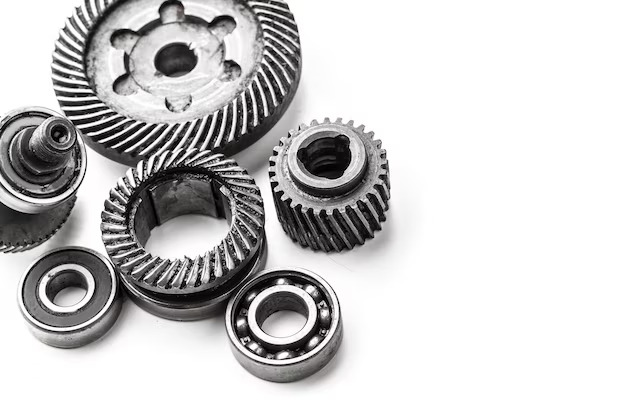
Introduction
Bearing is essential in the majority of mechanical uses, allowing for free motion and reduced friction between the moving parts. Yet, in choosing the correct bearing type, the choice will most often come down to either ball bearings or roller bearings. Both have distinct advantages and applications, which call for prior familiarity with their variations before making a choice.
In this article, we are going to discuss the primary distinctions between ball and roller bearings, their uses, advantages, and how to choose the best type for your specific requirement. Whether you are browsing from bearings & transmission wholesalers or looking for efficient ball bearing manufacturers, this guide will have you covered.
Understanding Ball Bearings
What Are Ball Bearings?
Ball bearings consist of small spherical balls that reduce rotational friction and support radial and axial loads. They function efficiently in high-speed operation and are commonly employed in motors, fans, and automotive components.
How Ball Bearings Work
Ball bearings operate by placing small metal balls between two smooth surfaces (races). The balls turn, distributing load and minimizing resistance, allowing the machine or part to turn freely with minimal loss of energy.
Advantages of Ball Bearings
-
High-Speed Performance – Ideal to be used where there is speedy rotation required.
-
Lower Friction – Rolling of the ball minimizes friction.
-
Versatile Applications – Electric motors, gearboxes, and home appliances all utilize ball bearings.
-
Compact Design – Little space required, small in size, and therefore ideal for mounting in small equipment.
Common Applications
-
Automotive wheels
-
Electric motors
-
Pumps and fans
-
Aerospace components
-
Industrial machinery
Understanding Roller Bearings
What Are Roller Bearings?
Roller bearings employ cylindrical, tapered, or needle-rollers instead of balls to withstand load over an extended area. This provides better load-carrying capacity and strength and bears roller bearings in extreme applications.
How Roller Bearings Work
When compared to ball bearings, roller bearings utilize rolling components with a larger contact area. This allows roller bearings to handle more weight but still provide satisfactory performance in manufacturing and automotive environments.
Advantages of Roller Bearings
-
Increased Load Capacity Carrying – Carries heavier radial and axial loads than ball bearings.
-
Durable – Service life longer, even under high-load conditions.
-
Better Shock Absorption – Is suitable for use in applications which are subject to impact loads.
-
Greater Stability – Reduces wear and tear due to increased area of contact.
Common Applications
-
Industrial gearboxes
-
Heavy machinery (e.g., mining equipment)
-
Conveyor systems
-
Agricultural machinery
-
Railway and automotive axles
Ball Bearings vs. Roller Bearings: Key Differences
When to Choose Ball Bearings
-
When there is a requirement of high-speed rotating
-
In those applications with moderate to light loads
-
If reduced friction and efficiency are prime factors
-
When space is limited and a compact design must be used
When to Choose Roller Bearings
-
When the load involves heavy radial and axial loads
-
When high durability and long life are important
-
In shock-resistant industries (e.g., construction, mining)
-
For applications that involve stable load distribution
Types of Roller Bearings and Their Applications
-
Tapered Roller Bearings – Designed to handle both radial and axial loads, commonly found in automotive hubs and gearboxes.
-
Cylindrical Roller Bearings – Provide high radial load capacity, ideal for electric motors and pumps.
-
Needle Roller Bearings – Compact and efficient, used in transmission systems where space is limited.
-
Spherical Roller Bearings – Can handle misalignment and heavy loads, making them suitable for heavy industries.
If you’re sourcing from tapered roller bearing manufacturers or plain bearing manufacturers, knowing the right type of roller bearing is crucial to ensuring longevity and optimal performance.
Case Study: Choosing the Right Bearing for an Industrial Application
A leading bulk bearings manufacturer was tasked with improving efficiency in an industrial conveyor system. The company initially used ball bearings but faced frequent breakdowns due to heavy loads and misalignment issues. After switching to spherical roller bearings, system performance improved significantly, reducing downtime by 40% and extending bearing lifespan by 60%.
Pros & Cons of Ball Bearings and Roller Bearings
Ball Bearings
✅ High-speed capability
✅ Lower friction
✅ Compact design
❌ Lower load capacity
❌ Less shock resistance
Roller Bearings
✅ Higher load-carrying capacity
✅ More durable under heavy stress
✅ Suitable for shock and vibration
❌ Higher friction compared to ball bearings
❌ Bulkier design
Conclusion
Choosing between ball bearings vs. roller bearings depends on your specific application needs. If you require high-speed performance with minimal friction, ball bearings are the right choice. However, if durability and heavy load capacity are your priorities, roller bearings provide superior performance.
Take the Next Step!
Looking for premium-quality ball bearings, roller bearings, or tapered roller bearings? Connect with industry-leading ball bearing manufacturers and tapered roller bearing manufacturers today to get the best deals. Drop a comment or contact us for expert guidance on selecting the right bearing for your needs!
FAQs
1. Which bearing type lasts longer?
Roller bearings typically have a longer lifespan due to their larger contact area and ability to handle heavy loads.
2. Can I use ball bearings in heavy-duty applications?
While possible, roller bearings are better suited for high-load conditions due to their superior load distribution.
3. Are tapered roller bearings better than ball bearings?
Tapered roller bearings can handle both radial and axial loads, making them preferable for automotive and heavy-duty applications.
4. How do I choose the right bearing for my application?
Consider factors like load type, speed, space constraints, and durability when selecting between ball and roller bearings.
5. Where can I find reliable bearing suppliers?
Trusted bearings & transmission wholesalers and bulk bearings manufacturers offer a wide range of quality bearings for different applications.